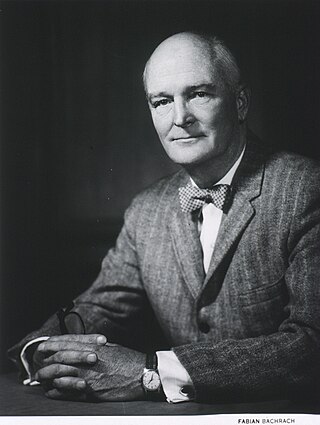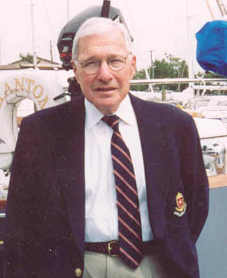
Michael Ellis DeBakey was an American general and cardiovascular surgeon, scientist and medical educator who became Chairman of the Department of Surgery, President, and Chancellor of Baylor College of Medicine at the Texas Medical Center in Houston, Texas. His career spanned nearly eight decades.
The National Heart, Lung, and Blood Institute (NHLBI) is the third largest Institute of the National Institutes of Health, located in Bethesda, Maryland, United States. It is tasked with allocating about $3.6 billion in FY 2020 in tax revenue to advancing the understanding of the following issues: development and progression of disease, diagnosis of disease, treatment of disease, disease prevention, reduction of health care disparities within the American population, and advancing the effectiveness of the US medical system. NHLBI's Director is Gary H. Gibbons (2012–present).

John Heysham Gibbon was an American surgeon best known for inventing the heart–lung machine and performing subsequent open-heart surgeries which revolutionized heart surgery in the twentieth century. He was the son of Dr. John Heysham Gibbon Sr., and Marjorie Young Gibbon, and came from a long line of medical doctors including his father, grandfather Robert, great-grandfather John and great-great grandfather.

Bernadine Patricia Healy was an American cardiologist and the first female director of the National Institutes of Health (NIH).

Paul M. Ridker is a cardiovascular epidemiologist and biomedical researcher. He is currently the Eugene Braunwald Professor of Medicine at Harvard University and Brigham and Women's Hospital, where he directs the Center for Cardiovascular Disease Prevention. Ridker also holds an appointment as Professor in the Department of Epidemiology at the Harvard T.H. Chan School of Public Health.

Faculty of Medicine, Dentistry and Health Sciences is the largest faculty of University of Melbourne, with the most post-graduate students, and also hosts the most school departments and centres of all University of Melbourne Faculties, consisting of 52 faculty sub-organisations. In 2021, Melbourne Medical School was ranked 25th in the world and second in Australia in the 2021 QS Subject Rankings.

Elizabeth Nabel is an American cardiologist and Executive Vice President of Strategy at ModeX Therapeutics and OPKO Health. Prior to this role, she served as President of Brigham Health and its Brigham and Women's Hospital, Professor of Medicine at Harvard Medical School, and Director of the NIH's National Heart, Lung, and Blood Institute.

K. Srinath Reddy is an Indian physician and the Former President of the Public Health Foundation of India and formerly headed the Department of Cardiology at All India Institute of Medical Sciences (AIIMS).

Sheldon Weinbaum: is an American biomedical engineer and biofluid mechanician. He is a CUNY Distinguished Professor Emeritus of Biomedical and Mechanical Engineering at The City College of New York. He is a member of all three U.S. national academies and also the American Academy of Arts and Sciences. In 2002 when he was elected to NAM he became the sixth living individual to be a member of all three National Academies and the first to achieve this distinction since 1992. He was the founding director (1994–1999) of the New York Center for Biomedical Engineering, a regional research consortium involving the BME program at The City College and eight of the premier health care institutions in New York City. He has been a lifelong advocate for women and minorities in science and engineering. He was the lead plaintiff and organizer of a class-action lawsuit charging New York State officials with racially discriminatory funding of its two university systems, CUNY and SUNY, the first CUNY faculty recipient of the Public Service Award of the Fund for the City of New York, and the Inaugural Recipient of the “Diversity Award” of the Biomedical Engineering Society (2009). He was the inaugural chair of the Selection Committee that chooses the annual Sloan Awardees for the outstanding math and science teachers in the New York City public high schools and served in this position from 2009 to 2019. In 2022 he received the Benjamin Franklin Medal in Biomedical Engineerings from the Franklin Institute in Philadelphia. In 2023 he received the National Medal of Science from President Biden.
James K. Kirklin is an American cardiac surgeon who has made significant scientific and surgical contributions in the fields of heart transplantation and mechanical circulatory support devices to assist the pumping action of the heart. He was formerly Professor of Surgery (1987-2022), Director of the Division of Cardiothoracic Surgery (2006-2016), Director of the James and John Kirklin Institute for Research in Surgical Outcomes (KIRSO) (2016–2022), and Co-Director of Comprehensive Cardiovascular Center (2011-2017) at the University of Alabama at Birmingham (UAB). While at UAB, he held the UAB Cardiovascular Research Chair (1998-2006), the John Kirklin Chair of Cardiovascular Surgery (2006-2017), and the James Kirklin Chair of Cardiothoracic Surgery (2017-2022).

Dr. Hannah Valantine is the Chief Officer for Scientific Workforce Diversity at the United States National Institutes of Health.

Edmund Hiram Sonnenblick was an American medical researcher and cardiologist. His studies of the function of cardiac muscle cells during the 1960s shaped the basis of both cardiovascular physiology and the modern treatment of cardiovascular disease, making possible the development of ACE inhibitors. In 1962, he was credited as the first person to image the heart muscle under scientifically-controlled conditions using the electron microscope. Though Sonnenblick's ideas about the relationship between the structure and function of the human heart today constitute medical-scientific commonsense, they were utterly novel at the time.
Barbara N. Horowitz, M.D., is a cardiologist, academic and author. She is a professor of medicine in the Division of Cardiology at University of California, Los Angeles (UCLA) and a visiting professor in the Department of Human Evolutionary Biology at Harvard University and has been on the faculty of Harvard Medical School since 2020. Horowitz is a New York Times bestselling author of the book Zoobiquity on the subject of a cross-species approach to medicine which includes veterinary and evolutionary perspectives. In 2019, Horowitz and Bowers co-authored their second book, Wildhood.
Joan Y. Reede is an American physician. She is Harvard Medical School's inaugural dean for diversity and community partnership in the Office of Diversity, Inclusion, and Community Partnership. She is also a member of the National Academy of Medicine. She is known for creating programs that mentor and support minority physicians and female physicians. Alumni of her programs have created a 501(c)(3) organization called The Reede Scholars in her honor.
Michael I. Kotlikoff is an American biomedical researcher, academic leader, and veterinarian who has served as the provost of Cornell University. His work on cardiovascular biology, optogenetics, mouse genetics, and ion channel function has been continuously funded by the National Institutes of Health since 1986. He has served on numerous NIH panels, including chair of the Scientific Board of Councillors of the National Heart, Lung, and Blood Institute (NHLBI) and the NIH Council of Councils, as well as national and international Higher Education committees, including Chair of the Jacobs Technion-Cornell Institute Board and the Advisory Committee for the CityUniversity of Hong Kong Jockey Club College of Veterinary Medicine.

Roderic Ivan Pettigrew is an American physicist, engineer, and physician who is CEO of EnHealth and Executive Dean for EnMed at Texas A&M University. From 2002-November 2017, he was the founding director of the National Institute of Biomedical Imaging and Bioengineering (NIBIB) at the National Institutes of Health (NIH). He is a pioneer and world expert in cardiovascular magnetic resonance imaging (MRI).
Daniel Levy is a cardiologist who is the director of the Framingham Heart Study at the National Heart, Lung, and Blood Institute, a division of the National Institutes of Health (NIH). He is also Professor of Medicine at Boston University School of Medicine. He is known for his research on the epidemiology and genetics of heart failure and hypertension.
Susan Redline is an American pulmonary specialist. She is the Peter C. Farrell Professor of Sleep Medicine and Professor of Epidemiology at the Harvard T.H. Chan School of Public Health.

Renee Yuen-Jan Hsia is an American emergency physician. She is a professor of Emergency Medicine and Associate Chair of Health Services Research at the University of California, San Francisco, as well as an attending physician in the emergency department at the Zuckerberg San Francisco General Hospital and Trauma Center. She is also a core faculty member of the UCSF Philip R. Lee Institute for Health Policy Studies. Her research is aimed at studying how health services and regionalization of care impact access to emergency care.

Michael S. Lauer is an American cardiologist and physician-scientist. He is the deputy director for extramural research at the National Institutes of Health (NIH).













